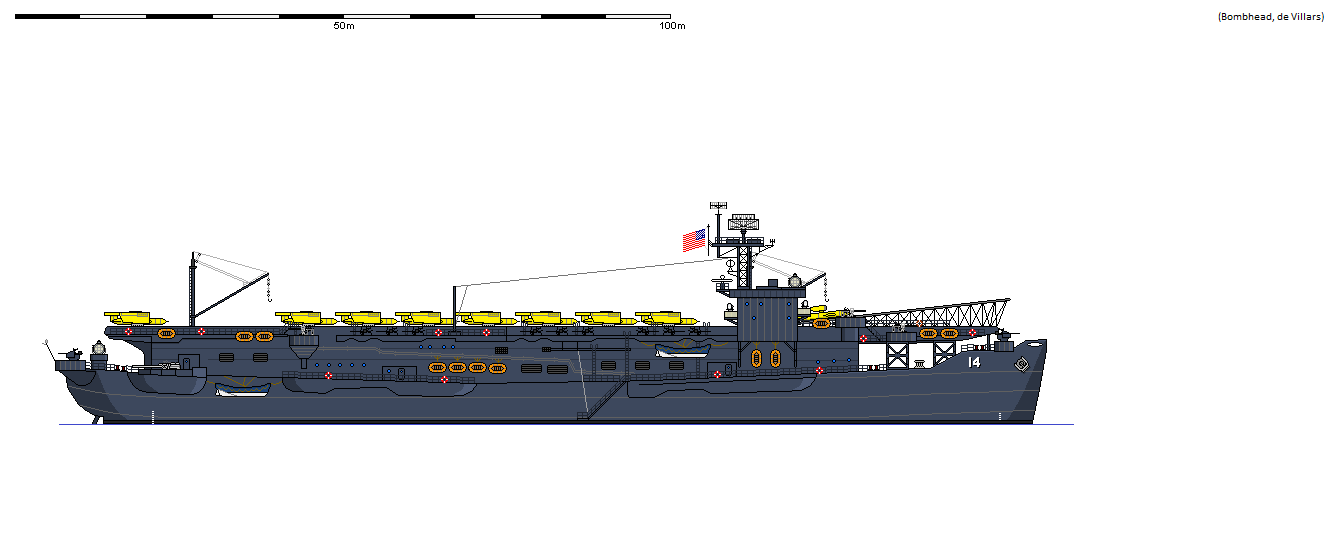Wybaczcie lakoniczność, ale ja już raz pisałem opis tego okrętu i mi go wcięło :/ A pisanie drugi raz tego samego to coś, czego szczerze nienawidzę. Zatem w skrócie: jest to zmodernizowany w latach 20-tych Lion, nieco na kształt Nelsona (nadbudówka, wieże 6-calówek). Z najważniejszych rzeczy wzmocniono opancerzenie (pokład nad maszynownią i burtowy pas pancerny – z wszystkimi zastrzeżeniami co do skuteczności takiego rozwiązania), zmodernizowano maszynownię, wymieniono kotły na opalane paliwem płynnym, dodano bąble, wymieniono artylerię średnią na 6-calówki (częściowo w wieżach, częściowo w kazamatach), dodano nową artylerię plot., zmodyfikowano kształt dziobu. Szerzej o modernizacji wypowiem się w komentarzach.
Lion, british battlecruiser laid down 1909 (Engine 1926)
Displacement:
26 091 t light; 27 647 t standard; 29 328 t normal; 30 674 t full load
Dimensions: Length overall / water x beam x draught
709,96 ft / 702,00 ft x 88,48 ft (Bulges 98,49 ft) x 27,49 ft (normal load)
216,40 m / 213,97 m x 26,97 m (Bulges 30,02 m) x 8,38 m
Armament:
8 - 13,50" / 343 mm guns (4x2 guns), 1 231,26lbs / 558,49kg shells, 1909 Model
Breech loading guns in turrets (on barbettes)
on centreline, evenly spread, 1 raised mount
Aft Main mounts separated by engine room
8 - 5,98" / 152 mm guns (4x2 guns), 107,15lbs / 48,60kg shells, 1921 Model
Quick firing guns in turrets (on barbettes)
on side, all forward
4 - 5,98" / 152 mm guns in single mounts, 107,15lbs / 48,60kg shells, 1921 Model
Quick firing guns in casemate mounts
on centreline, all aft, all raised mounts - superfiring
4 - 4,72" / 120 mm guns in single mounts, 52,72lbs / 23,91kg shells, 1925 Model
Anti-aircraft guns in deck mounts
on side, all amidships, all raised mounts - superfiring
4 - 1,85" / 47,0 mm guns in single mounts, 3,17lbs / 1,44kg shells, 1914 Model
Quick firing guns in deck mounts
on side, all forward, all raised mounts - superfiring
Weight of broadside 11 359 lbs / 5 153 kg
Shells per gun, main battery: 150
2 - 21,0" / 533 mm submerged torpedo tubes
Armour:
- Belts: Width (max) Length (avg) Height (avg)
Main: 11,0" / 279 mm 326,08 ft / 99,39 m 11,48 ft / 3,50 m
Ends: 6,50" / 165 mm 248,10 ft / 75,62 m 17,95 ft / 5,47 m
127,82 ft / 38,96 m Unarmoured ends
Upper: 5,98" / 152 mm 326,08 ft / 99,39 m 6,50 ft / 1,98 m
Main Belt covers 71% of normal length
Main belt does not fully cover magazines and engineering spaces
- Torpedo Bulkhead and Bulges:
2,48" / 63 mm 163,65 ft / 49,88 m 24,84 ft / 7,57 m
- Gun armour: Face (max) Other gunhouse (avg) Barbette/hoist (max)
Main: 9,02" / 229 mm 9,02" / 229 mm 9,02" / 229 mm
2nd: 5,98" / 152 mm 4,02" / 102 mm 5,98" / 152 mm
- Armour deck: 2,52" / 64 mm (5,51" /140 mm over ammunition room, 3,27" /83 mm over machinery), Conning tower: 12,01" / 305 mm
Machinery:
Oil fired boilers, steam turbines,
Geared drive, 4 shafts, 96 178 shp / 71 749 Kw = 28,00 kts
Range 7 400nm at 14,00 kts
Bunker at max displacement = 3 027 tons
Complement:
1 119 - 1 456
Cost:
£2,537 million / $10,148 million
Distribution of weights at normal displacement:
Armament: 1 420 tons, 4,8%
Armour: 9 825 tons, 33,5%
- Belts: 3 528 tons, 12,0%
- Torpedo bulkhead: 373 tons, 1,3%
- Armament: 2 551 tons, 8,7%
- Armour Deck: 3 128 tons, 10,7%
- Conning Tower: 246 tons, 0,8%
Machinery: 3 079 tons, 10,5%
Hull, fittings & equipment: 11 717 tons, 40,0%
Fuel, ammunition & stores: 3 237 tons, 11,0%
Miscellaneous weights: 50 tons, 0,2%
Overall survivability and seakeeping ability:
Survivability (Non-critical penetrating hits needed to sink ship):
41 390 lbs / 18 774 Kg = 33,6 x 13,5 " / 343 mm shells or 6,0 torpedoes
Stability (Unstable if below 1.00): 1,13
Metacentric height 5,3 ft / 1,6 m
Roll period: 18,0 seconds
Steadiness - As gun platform (Average = 50 %): 58 %
- Recoil effect (Restricted arc if above 1.00): 0,54
Seaboat quality (Average = 1.00): 1,17
Hull form characteristics:
Hull has rise forward of midbreak
Block coefficient: 0,540
Length to Beam Ratio: 7,13 : 1
'Natural speed' for length: 26,50 kts
Power going to wave formation at top speed: 51 %
Trim (Max stability = 0, Max steadiness = 100): 50
Bow angle (Positive = bow angles forward): 14,00 degrees
Stern overhang: 0,00 ft / 0,00 m
Freeboard (% = measuring location as a percentage of overall length):
- Stem: 31,92 ft / 9,73 m
- Forecastle (21%): 26,44 ft / 8,06 m
- Mid (66%): 24,44 ft / 7,45 m (15,45 ft / 4,71 m aft of break)
- Quarterdeck (16%): 15,94 ft / 4,86 m
- Stern: 17,45 ft / 5,32 m
- Average freeboard: 22,98 ft / 7,00 m
Ship space, strength and comments:
Space - Hull below water (magazines/engines, low = better): 94,5%
- Above water (accommodation/working, high = better): 165,6%
Waterplane Area: 42 946 Square feet or 3 990 Square metres
Displacement factor (Displacement / loading): 107%
Structure weight / hull surface area: 181 lbs/sq ft or 882 Kg/sq metre
Hull strength (Relative):
- Cross-sectional: 0,97
- Longitudinal: 1,27
- Overall: 1,00
Hull space for machinery, storage, compartmentation is adequate
Room for accommodation and workspaces is excellent
Lion (1910, rebuilt 1926)
Princess Royal (1911, rebuilt 1927)


















